Mughals and Sultans ruled much of northern India in the 16thand 17th centuries leaving behind beautiful architecture. We visited three sites that are not often visited by tourists, and we’re so happy we did.
Forty km east of Agra is the historical ancient city of Fatehpur Sikri. The capital was moved here for 15 years in the late 16th century by Shah Akbar, who also built Agra Fort. He moved the capital to Fatehpur Sikri after a local sage accurately predicted the birth of his son and heir to his empire. The capital was moved back to Agra after his death. There is no grand entry to the fortress, but there are many fascinating buildings inside. There’s a large open courtyard surrounded by red sandstone buildings with an ornamental pool at one end. Most of the buildings from afar look plane, but on closer look you find intricately carved designs on the vaulted ceilings, walls and columns.






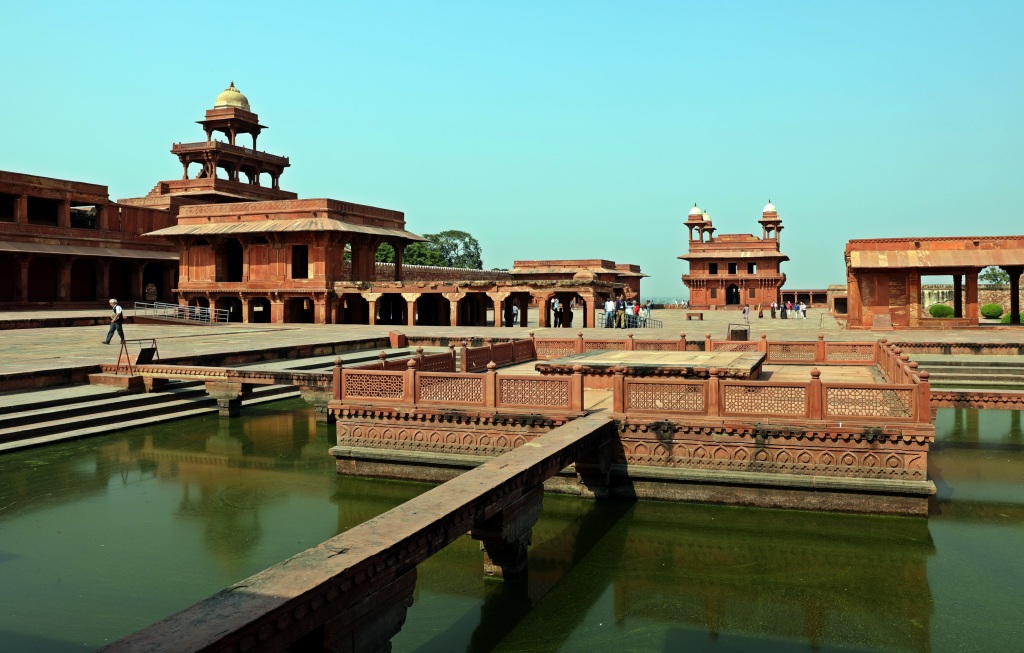

The Hall for Private Audience is a very interesting building. There are 4 white-domed chhatris on each corner of the roof. Inside is a large engraved pillar with raised walkways going from the pillar top to the building’s walls. Akbar debated with different religious leaders here, each standing at a different corner of these walkways.


In the middle of the grounds is Panch Mahal, a 5-tiered open-air building with many pillars on each level. Akbar spent his evenings on the top tier enjoying the cool breeze and the view with ladies from his harem.
On the edge of the fort is a row of rooms which is residence for his harem of 5000 as well as 250 maids. Apparently, there was a passage from the harem to the 5-tiered Panch Mahal.




Much of the fortress has been renovated, but behind the renovated area we found a beautiful old, large gate with elephant carvings. The path from this gate led to a tall, strange pillar that looks like a hairbrush with pointy barbs. The barbs are actually stone carvings that are supposed to represent elephant tusks.


Beside the fortress is a large mosque, Jama Masjid, that was also built by Shah Akbar. The mosque is surrounded by a huge wall of red sandstone brick with an elaborate high arched gate. Inside is a large open courtyard with a few small buildings. One of the buildings is a simple mosque with a long prayer room. Another is a white tomb for the sage that predicted the birth of Akbar’s son.





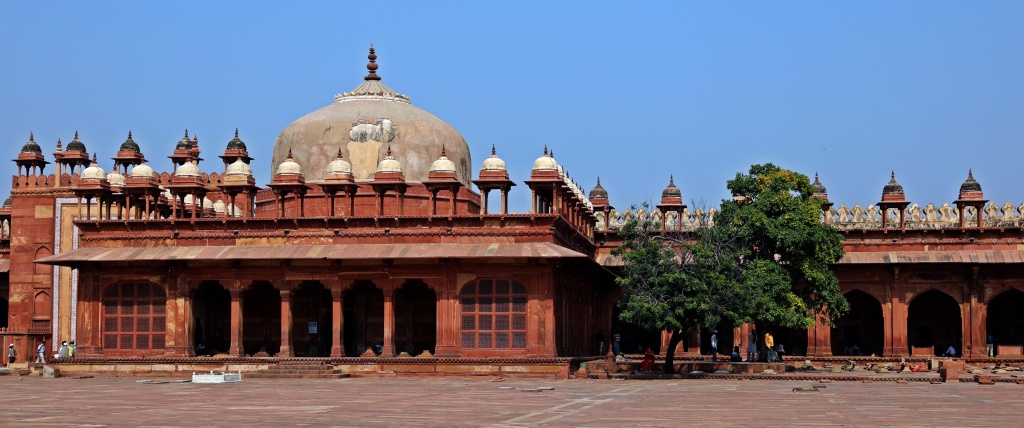

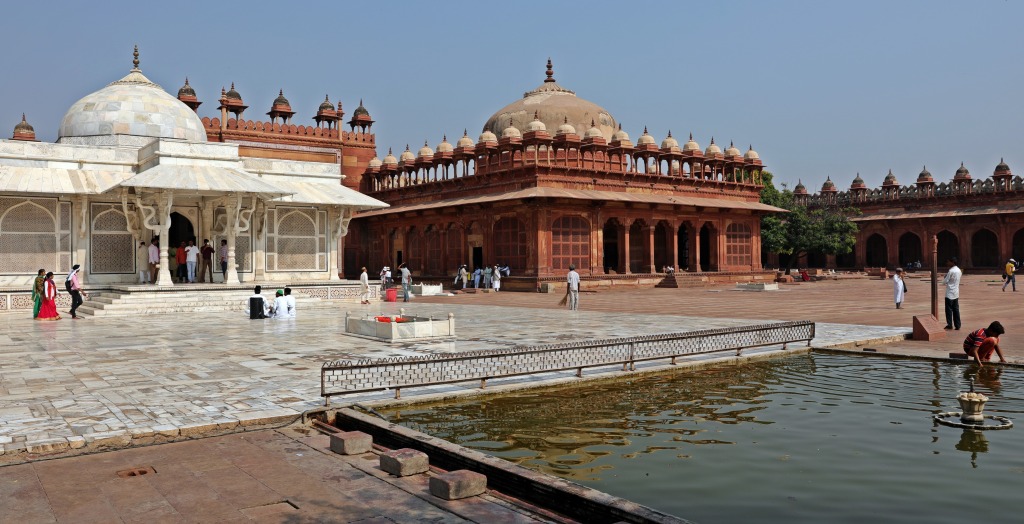

East of Agra is a run-down town with an ancient hill-top fort. There is a 3km long plateau on top of the hill and Gwalior Fort spreads along most of it. The fort’s first buildings were built under Sultan rule and later ones by Hindu Maharajahs. There aren’t many buildings remaining inside the fort walls, but we were able to visit a few of the remaining ones.

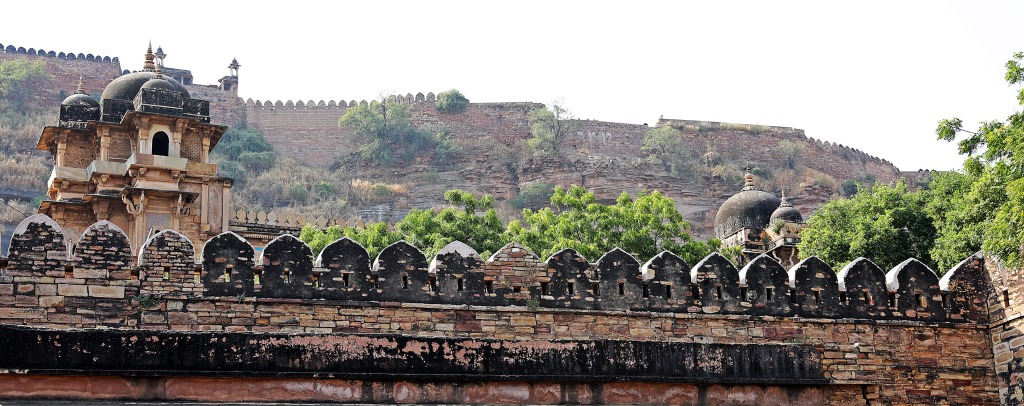



Inside for fort walls is an 8th century aqueduct with an interesting legend. Apparently, a hermit used water from the aqueduct to cure a Sultan chieftain of leprosy. The hermit then told the chieftain that as long as his family used the name Pal, they would remain in power. Legend goes that they did and only lost the kingdom when the 84th descendant changed his name.


Across from the aqueduct is a colourful 15th century Hindu Palace called Man Singh Palace. The outer walls are painted with blue, yellow and green tiles with depictions of ducks, elephants, crocodiles and lions. Inside are two courtyards with remnants of colourful tiles and elaborate carvings on the walls and doorways. There were many small rooms off the courtyards and a few had bats hanging from the ceilings.





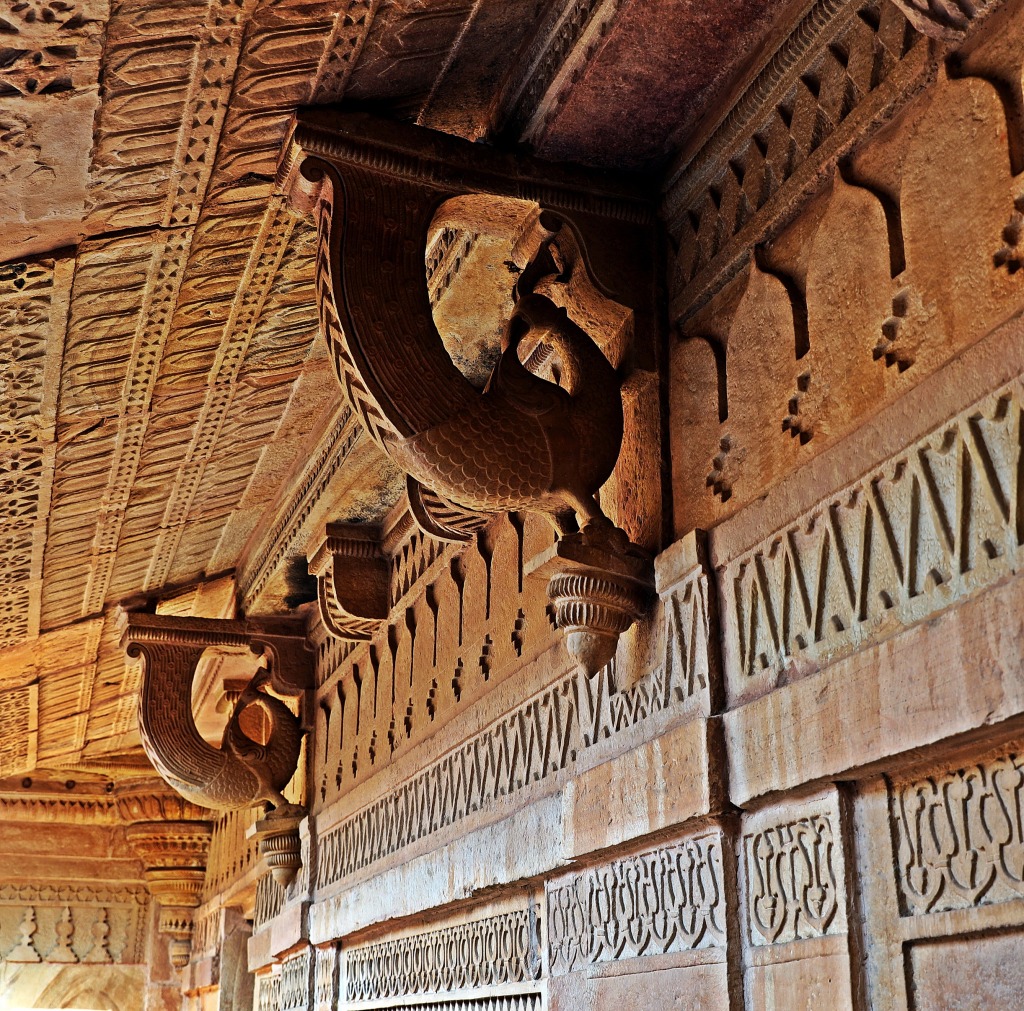


The unusual feature of this palace is the two-stories of basements with circular rooms surrounded by large pillars. The basements were used in the summer months to keep cool, but later the Mughals used the basements to hold prisoners. The rooms were quite eerie and it was easy to imagine prisoners being locked up in them for years.

Further down the road, within the fort walls we found two Hindu temples called Mother-In-Law and Daughter-In-Law Temples. Both temples are decorated inside and out with hundreds of small sculptures on the pillars, walls, doorways. They’re quite beautiful.


Teli Ka Mandir is an interesting 8th century temple. It’s a tall, stone building with many carvings on the exterior. What makes it different is the a rounded wagon-style roof. It is the oldest building in the fort grounds. Apparently when the British were in power, they used this temple as a tea house.

Down the hill on the backside of the fort, outside of the wall, are huge 15th century carvings up to 5m tall, carved right into the cliff. They are carvings of the 24 Jain teachers. Jain is an ancient religion, as old as Buddhism. (More on Jainism in an upcoming blog.) Many of the carvings are being renovated after years of carnage, but you can still see much of the original detail that went into these.




In Gwalior we went to the iconic Indian Coffee House. The coffee wasn’t very good, but the waiters in their white, safari suits and peacock hats were worth the visit. As usual, there were many cows roaming the streets, including one we saw entering a restaurant.


Further east, the town of Orchha has some of the most remarkable buildings in the area. They are from the 16th – 18th centuries and all are within a few minutes’ walk of each other. Jehangir Mahal is a huge palace with a large inner court yard with many rooms on each side. Above there are three floors of terraces, wrapping around the courtyard. They look over the courtyard and the outside to the surrounding buildings. There were dozens of narrow, stone stairwells leading up to them. At the corners of the top terrace are large domed chhatris with smaller chhatris along each wall. The building has such elaborate architecture and so much character, it was one of the most interesting buildings we’ve seen. Even the monkeys like it. There was a troupe of Hanuman monkeys with very longs tails hanging out on the top tier of the Mahal.







The rear gate of Jehangir Mahal has a very impressive large wooden door with elaborate carvings on both sides of the door including two large elephant carvings. Behind this gate is a stable for camels with really tall doors. The palace is supposedly set in a lush garden, but it was in a disheveled yard from what we saw.



Across from Jehangir Mahal is Raj Mahal. It’s a much plainer looking building from the outside, but the rooms inside are very elaborate. They are decorated with gorgeous frescoes of people, horses, elephants, and the Hindu Gods Rama and Krishna. Many of the frescoes were quite damaged, but we were able to find a few in good condition.


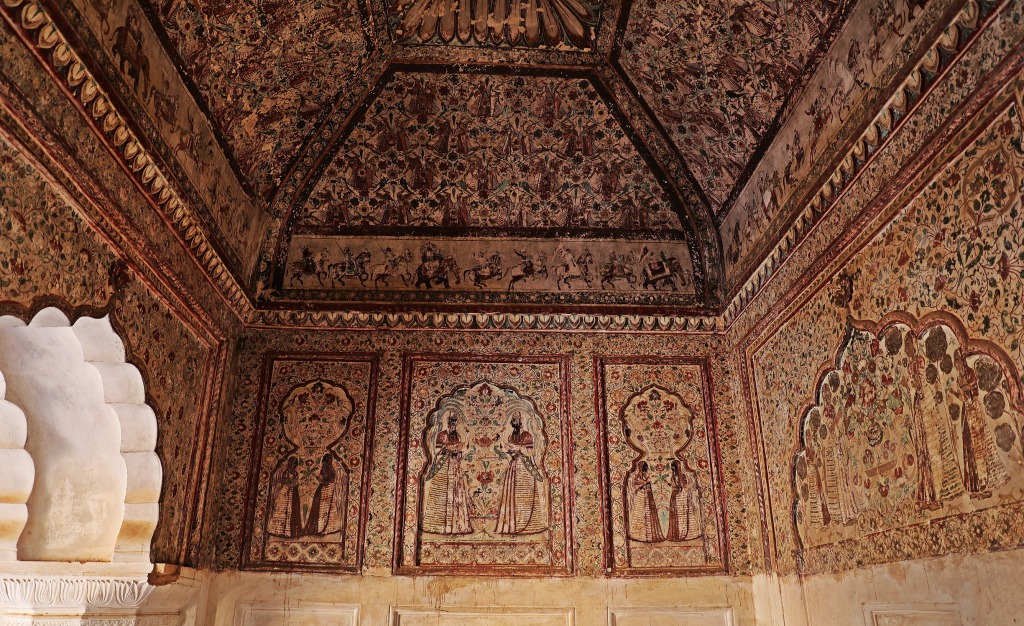
A small building across the river, Palki Mahal, is in disrepair but has an interesting history. The owner was charged with committing adultery with his brother’s wife. To prove his innocence, he committed suicide. Now he is regarded as a hero by local women. There is a memorial for him in a nearby garden (Phool Bagh). Women believe he will grant their wishes if they walk five times around his memorial and tie a string to a fence. The nearby fence was covered in string!

Chaturbhuj Temple is very impressive from the outside. It has high spires that are elaborately decorated with many carvings. The inside however is quite ordinary with a simple shrine at the front. There are multiple stairwells to reach the temple’s roof. The staircases are very steep. Each step is almost knee high, but with a very small area for your foot so we had to go sideways. Climbing up was tough, but down was even worse. From the roof though, we had nice views of the river valley and the other buildings of Orchha.
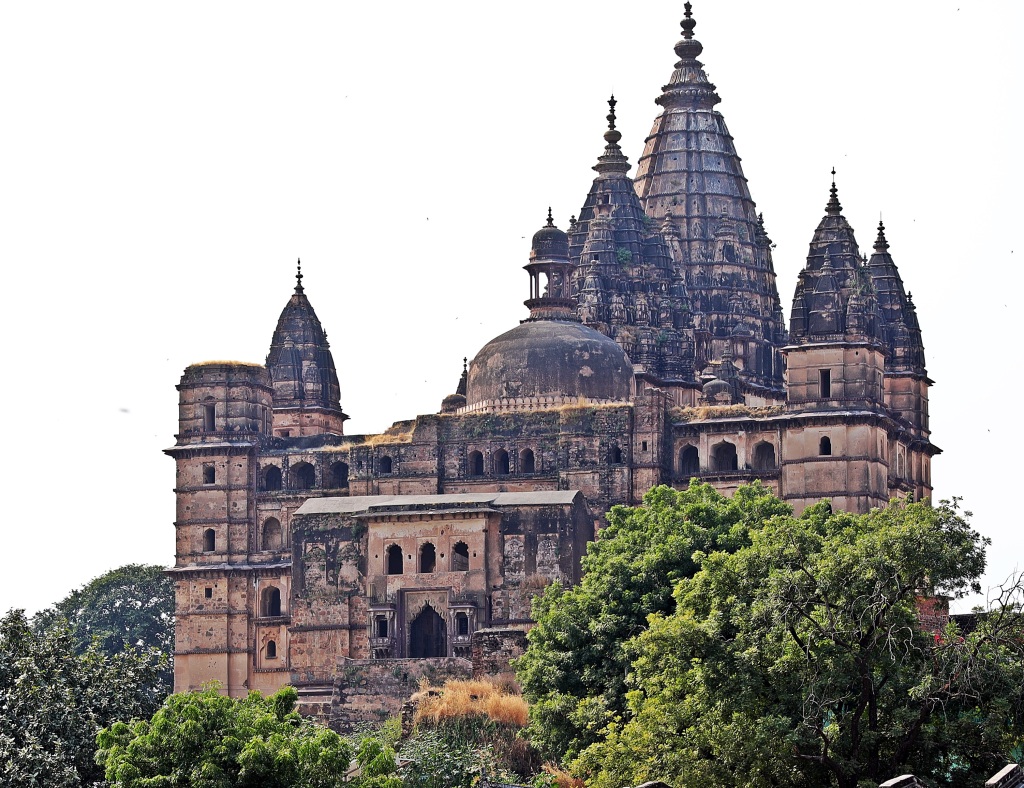



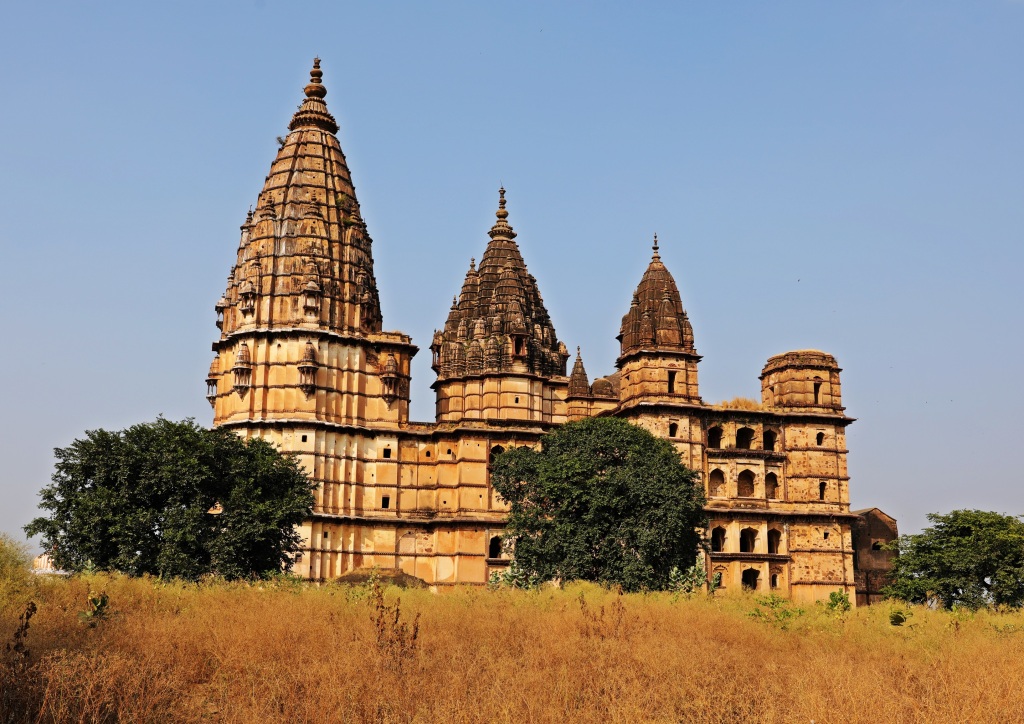
Further down the river is a walled area with a well-maintained garden and 12 cenotaphs (monuments) for Mughal leaders from the 17th and 18th centuries. They are still in very good condition with a lovely garden setting. Orchha was a nice surprise as it’s not highly publicized but has such an incredible architecture and history.


Coming up next: Bodhgaya and Parasnath Hills.
For extra pics from this trip go to Gallery/Delhi & Eastern India. For extra pictures from other blogs go to Gallery at monkeystale.ca
To read about more of our adventures go to Destinations.
If you like what you read, please share it using the links below.
fantastic – there is just so much to see and discover in India!! Unbelievable!! 😀
LikeLiked by 1 person
It is an amazing country with so much more to see than we expected.
LikeLiked by 1 person
Wow! I was captivated by your treks and now this. The architecture, hill-top fort, cliff carvings..are incredible. What an amazing country.
LikeLiked by 2 people
India has really been a great surprise. There is so much history with interesting site. Don’t think travel in India is easy, it’s difficult, but very rewarding.
LikeLiked by 1 person
Another great post. Such brilliant photographs. Wonderful clicks there!
LikeLiked by 1 person
Thank you so much
LikeLiked by 1 person
Wouw… beautiful buildings. this is the kind of things I love to see when travel. The photos are vivid and it seems you explore a lot of places there. Interesting photo about the cow entering the restaurant:)
LikeLiked by 1 person
Thanks, we’ve seen so many amazing sites in India. Many we nothing about before arriving so we were pleasantly surprised.
LikeLiked by 1 person
good to know. Mickey wants to go there but I am a bit skeptical as I heard so many stories either you hate it or you love it:) So, I think we have to wait to explore India until the last:)
LikeLiked by 1 person
We heard the same comments. It is difficult in India, everything seems to be more difficult – booking trains, getting tourist info, dealing with touts and everyone wants money from you. But, it is such an interesting place with diverse people and great food! After traveling in Asia I don”t think you’ll find it as hard, but people who have never been to SE Asia, it would be a shock.
LikeLiked by 1 person
Yes, I love Asian countries, however I had trouble when I was in Sri Lanka since I travel alone and man all following me and I get hassle quite a lot there and to be honest, I do not like Sri Lanka as the nature, accommodation and transport was a bit difficult as well. Maybe in the future we will visit India but it has to wait I think as I prefer to visit other countries.
LikeLiked by 1 person
I wouldn’t recommend India as a solo female unless you stick the the himalayas. The peole are very kind there. They do stare a lot in the rest of India though. I thought you were 2 people traveling.
LikeLiked by 1 person
Yes. usually we travel together, however sometimes I travel alone as Mickey is working and can not get a holiday:)
LikeLiked by 1 person
I’m re-reading with an aim of carving out a rough itinerary. It looks like there are lots of great attractions around Agra. Did you use it as a base to visit these places? How many days did you stay? I owe you a coffee (actually many coffees) for all your travel advice.
LikeLike
We did use Agra as a base. I think we had 4 nights. One day for Fatehpur Sikri, one day for the the taj and red fort. One day for baby taj, Akbar’s tomb, mehtab bagh. We stayed one night in Gwaliar to visit its fort and Orchha but we used public buses. You can probably do it in a day with a driver. Gwaliar can be missed but Orchha was excellent. For visiting the Taj, our hotel told us we didn’t need to go too early as it’s only the foreigners in line. We arrived approx 30 min before opening and there was a huge line. The main problem was there were already tons of people in our pictures, but when we look at them now, it doesn’t spoil it. At 8am Indians are allowed in and very quickly the grounds are full. Agra the town is disappointing so don’t expect much. Happy planning!
LikeLike
Thanks for this helpful info Maggie. I’m bracing myself for the Taj crowds. You’re right about your Taj photos. I felt the same when we were at Angkor Wat during Chinese New Year…somehow the photos still look good. Perhaps you have been spoiled by all the amazing Indian architecture. Your photos of Gwaliar are gorgeous.
LikeLiked by 1 person
Looking back at the pictures, Gwalior does look great, but maybe we had expected too much. It was disappointing at the time.
LikeLiked by 1 person